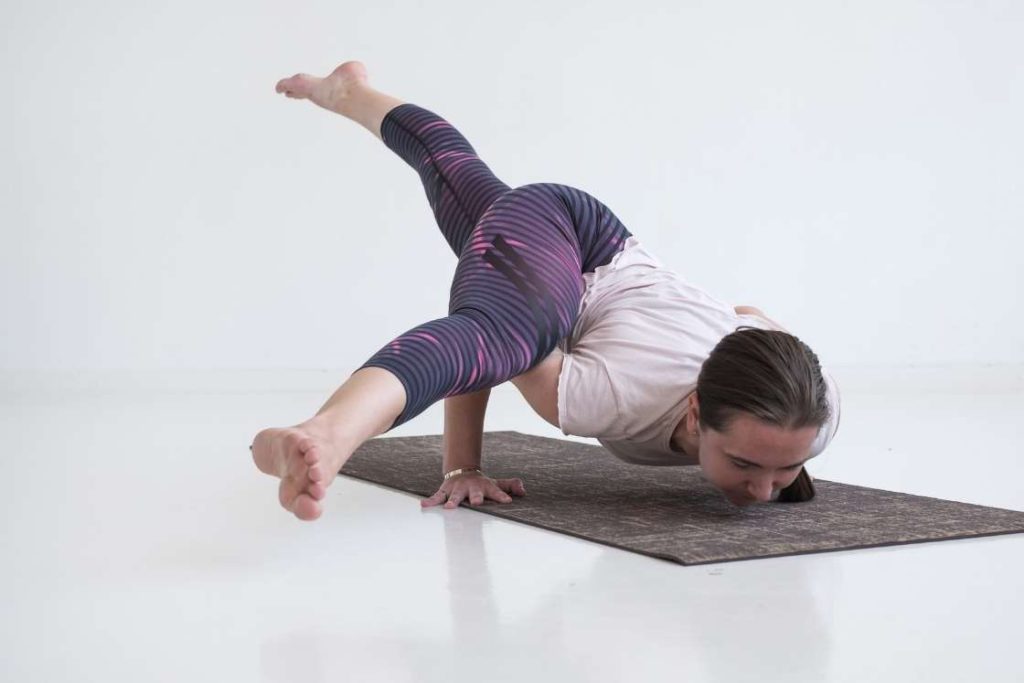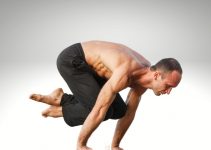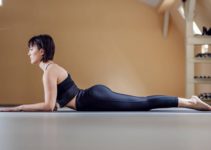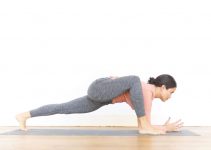
| Sanskrit Pronunciation | Eka Pada Koundinyasana 2 (EY-kuh Pah-duh kown-din-YAHS-ah-nuh 2) |
| Meaning | Eka = one / Pada = legged / Koundinyasana = Sage Koundinya’s Pose |
| Pose Type | Arm balancing |
| Pose Level | Advanced |
| Muscles engaged | Triceps, biceps, core, glutes, hamstrings, and hip |
| Other Names | Hurdler pose, Pose Dedicated to the Sage Koundinya II |
Eka pada koundinyasana 2 aka hurdler pose is an advanced arm balancing pose. Here the torso is raised parallel to the floor and balanced on the bent elbows. Besides balancing, it involves twisting element as well because the lower body is twisted with one leg extended backward while the other to the side.
A lot of practice and preparation is required for such an intense posture that can be mastered by investing time on hamstrings opening and gathering complete awareness.
Meaning
To understand its meaning, diving on the root terms that are derived from Sanskrit comes in handy. The term, “Eka” refers to “one“, “Pada” is foot, and “Koundinya” denotes the name of an ancient sage.
The sage mentioned above was a Buddhist monk who forecasted the destiny of Gautam Buddha at the time of his birth about reaching enlightenment. A great amount of faith on oneself is required to assume this challenging posture, similar to the belief of Sage Koundinya on his own prediction.
The final posture also resembles front splits hovering over the floor, hence sometimes it is also referred to as Flying Splits Pose or Twisted One Legged Arm Balance Pose. This pose benefits the practitioner in reaching higher meditative states where one can take control over mental and physical stability.
Practice Guide
The pose is already a complicated one, hence, some safety measures as well as preparatory practice is a must to get going. Follow these guidelines to land into the pose safely avoiding any complications.
Contraindications
Keep the following points in mind if you are planning to include Eka Pada Koundinyasana 2 into your yoga practice so that you can get its benefits and avoid anything that might cause you harm.
- Avoid practice this asana if you have an injury around arms, hips, lower back, or abdominal region.
- People with arthritis, carpal tunnel syndrome, spondylitis, or sciatica must abstain from this practice.
- If your are suffering from Irritable Bowel Syndrome, then, it’s better not to pressurize yourself to practice this pose.
- Women must avoid it during menstruation and pregnancy.
- People with heart or blood pressure issues must avoid this pose.
Preparatory Poses
Before stepping into Eka Pada Koundinyasana 2, you need the master the following poses to prepare the body well. These include hip-openers and balancing poses that brings stability over movement and are given below:
- Four-Limbed Staff Pose (Chaturanga Dandasana)
- Reclining Hand-to-Big-Toe Pose (Supta Padangusthasana)
- Wide Angle Seated Forward Bend (Upavistha Konasana)
- Crow Pose (Bakasana)
- Eight Angle Pose (Astavakrasana)
- Boat Pose (Navasana)
How to Do Eka Pada Koundinyasana II (Steps)
- Get into lizard pose with left leg forward and lift your elbows off the floor straightening the arms.
- Slide your left arm under your left leg and place your palm on the floor outside of your left foot. Stack the left knee under the left shoulder.
- Flexing the elbows bring the upper arms parallel to the floor as in Chaturanga.
- Gradually straighten the left leg rest the left thigh onto the left upper arm and lift your toes off the floor.
- Transfer your weight onto your arms to lift the right foot from the floor behind you, keeping the thighs engaged in maintaining the lift.
- Fix your gaze on the floor in front of you.
- Hold this balancing pose for five breaths.
- Release the pose by lowering the back foot to the floor and repeat it on the other side.
Follow-Up Poses
- Child’ Pose (Balasana)
- Downward Facing Dog Pose (Adho Mukha Svanasana)
- Standing Forward Bend (Uttanasana)
Precautions
There are some common mistakes that anyone can fall prey to while attempting Eka Pada Koundinyasana II, which might lead to an accident or injury. Hence, follow these precautionary measures while practicing this posture.
- Keep your shoulders square and shoulder blades squeezed together to avoid collapsing through the shoulders.
- Keep your arms close to your sides as much as possible.
- Practice this pose only when you have gained enough strength and control over your balance.
- Keep an additional cushion on the floor near your face, in case, you fall while practicing.
Benefits of Eka Pada Koundinyasana II
The major benefits of this posture are given below which tempts the yogis to practice it despite of all the challenges and difficulties.
1. Strengthen the arms and legs
The body is balanced completely over arms in the final pose, leaving an intense stretch on the shoulders, elbows, and wrists. Hence, it stimulates the muscles in the triceps and biceps and strengthen them. Also, the thighs and hamstrings are stretched that stimulates blood flow in the lower body improving the legs strength.
2. Enhances core strength
The abdominal region is activated while practicing this pose that not only improves the digestion but also improves the blood circulation around core muscles. Thus, it strengthens the core as well.
3. Relieves tension around the sit bones
This is an intense hip-opener pose. It stimulates the glutes relieves the muscular tension that often get accumulated around the buttocks due long hours of sitting. Thus, it improves hips flexibility and mobility.
4. Burns belly fat
Since, core muscles are contracted while attempting this pose, it is helpful in getting rid of stubborn belly fat. It is an ideal practice to tone the entire body and maintain a healthy and fit posture.
5. Boosts confidence
Achieving balance in this pose helps the practitioner to draw inward awareness and builds faith. Besides this, eka pada koundinyasana II also stimulates the solar plexus chakra that boosts the waves of self-confidence within the practitioner.
6. Improves spinal flexibility
Since it is known for strengthening the core muscles, it also develops a strong foundation for the muscles that supports the spine. The spinal muscles are also stretched which enhances its suppleness and flexibility.
Conclusion
Trust your practice and preparation to hop into your mat for getting into Eka Pada Koundinyasana II. It will enhance not only your health but also elevates the quality of your living.
Just be patient with your practice and observe improvement in your overall physical and mental health state,




